Final report for OW22-372
Project Information
There is an urgent need for resilient soil, grass, and pollinator habitat in our rangelands. This can only be achieved through fiscally viable approaches. This project attempts to demonstrate, with our producer partners as the focus, alternative practices to promote healthy pollinator populations and resilient soils and grass in rangeland. Currently, rangeland producers generally don’t consider that what is good for the bovine is good for the bee. We aim, with this research, education, and resulting business plan inputs, to demonstrate whether there are significant agricultural operation benefits to adjusting practices to use cows to ingest pollinator-friendly native grass seed, then pass and subsequently plant the grasses to (benefit) maximize pollinator populations. An additional opportunity for an on-ranch enterprise could be applied to new partnerships with beekeepers or start hives of their own.
We Are For The Land Foundation proposes this project to directly support producers in the Greater Yellowstone Ecosystem specifically and in Southwest Montana, who are interested in deepening their understanding of soil health, water cycle, alternative approach native grass dispersal and growth, and pollinator communities. Sharing and exhibiting to producers several monitoring and testing techniques to illustrate the benefits of maximizing inputs for profitability and land health. Having a better understanding of what this looks like empowers producers to make more informative financial and land management decisions. Having more data will hopefully allow producers to increase the productivity of their grazing lands and decrease their inputs in management.
Objective 1: Increase producer and consumer interest in the connection between soil health, pollinators, and grazing in the Greater Yellowstone Ecosystem.
Objective 2: Build and support a coalition of producers who are adaptive grazing, who interested in increasing their pollinator communities and who are interested in connecting with Montana apiarists.
Objective 3: Test adaptive grazing plans with participating producers to support pollinators.
Objective 4: Measure pollinators and soil health over 3 years in several locations.
Objective 5: Provide community promotion of engaged producers involved in the project.
Objective 6: Collect and share the economics of the considered practices involved in this project.
Cooperators
- - Producer
- - Producer
- - Producer
- - Technical Advisor (Educator)
- - Producer
- - Technical Advisor
- - Technical Advisor (Researcher)
- - Producer (Researcher)
- - Technical Advisor (Educator and Researcher)
- - Technical Advisor
Research
From 2022–2024, the Buzz on the Range project tested whether cattle could disperse and establish pollinator-friendly plants through endozoochory (seed passage through digestion) in combination with adaptive grazing and bale grazing. Research took place on five Montana ranches: Anderson Ranch, Barney Creek Livestock, Keeywadin Ranch, Milk Maid Meats, and West Creek Ranch. Activities followed the original research objectives, with adjustments made for weather, logistics, and partner input.
1. Pollinator Promotion via Endozoochory
Objective: Determine whether ruminants can spread, stomp, and water native pollinator-promoting plants in a cost-effective way.
Methods:
Seed Dispersal Protocol
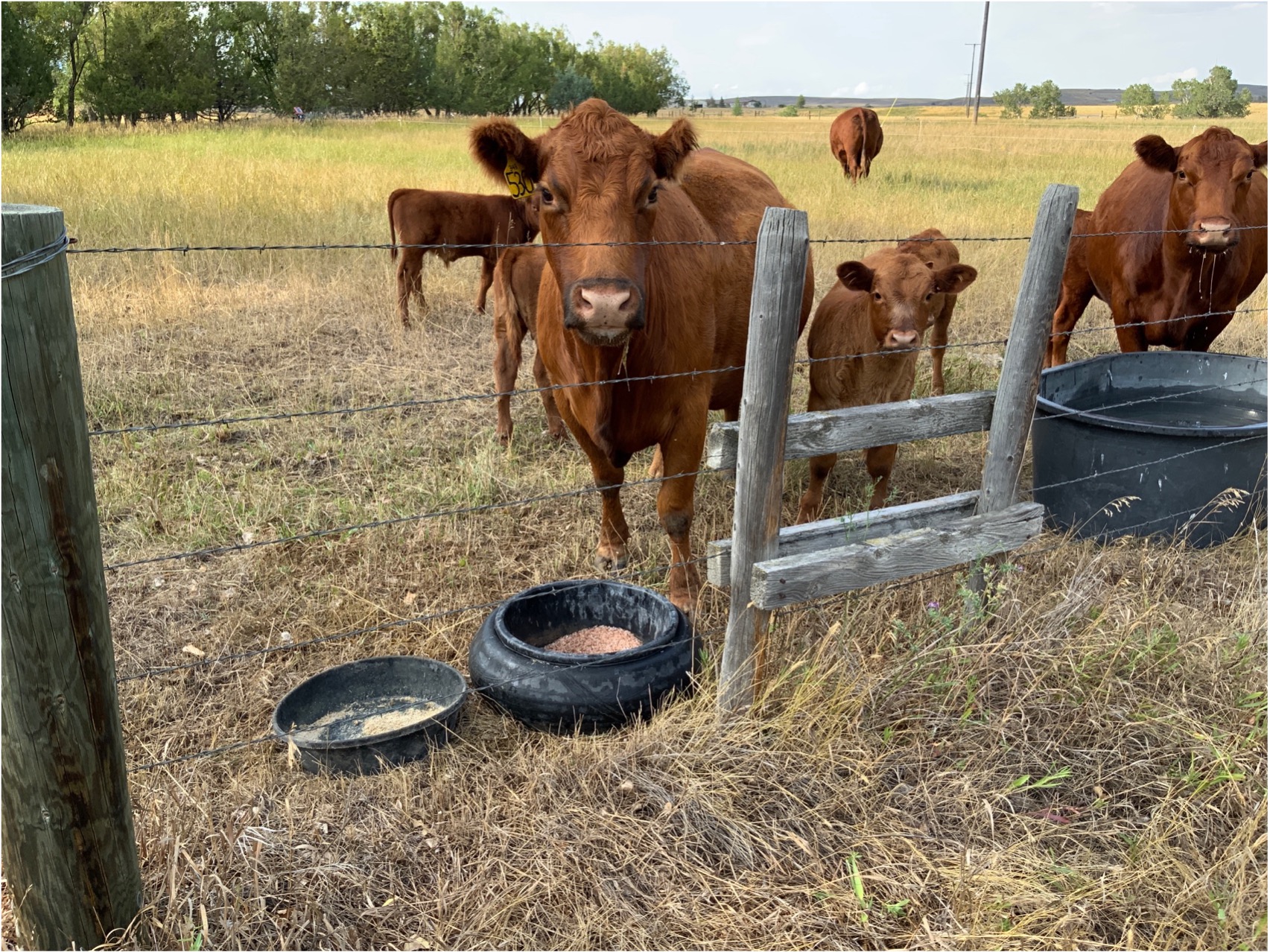
Cattle consuming seed-enhanced mineral supplement as part of the endozoochory dispersal protocol
Endozoochory is the scientific term for seed dispersal through animal digestion. In our project, we used cattle as living seed distributors by feeding them pollinator-friendly native plant seeds mixed with mineral supplements.
- Mixed pollinator seed into loose mineral feed at a ratio of 6 cups seed to 5 gallons mineral.
- Allowed cattle to consume the seed-mineral mix during normal feeding.
- Seeds passed through the digestive system with varying viability rates.
- After 24 hours, moved cattle into ~1-acre research paddocks for 1–3 days to distribute seeds via manure, hoof action, and urine.
- Paddocks enclosed with temporary electric fencing to standardize size, control grazing intensity, and facilitate follow-up monitoring.
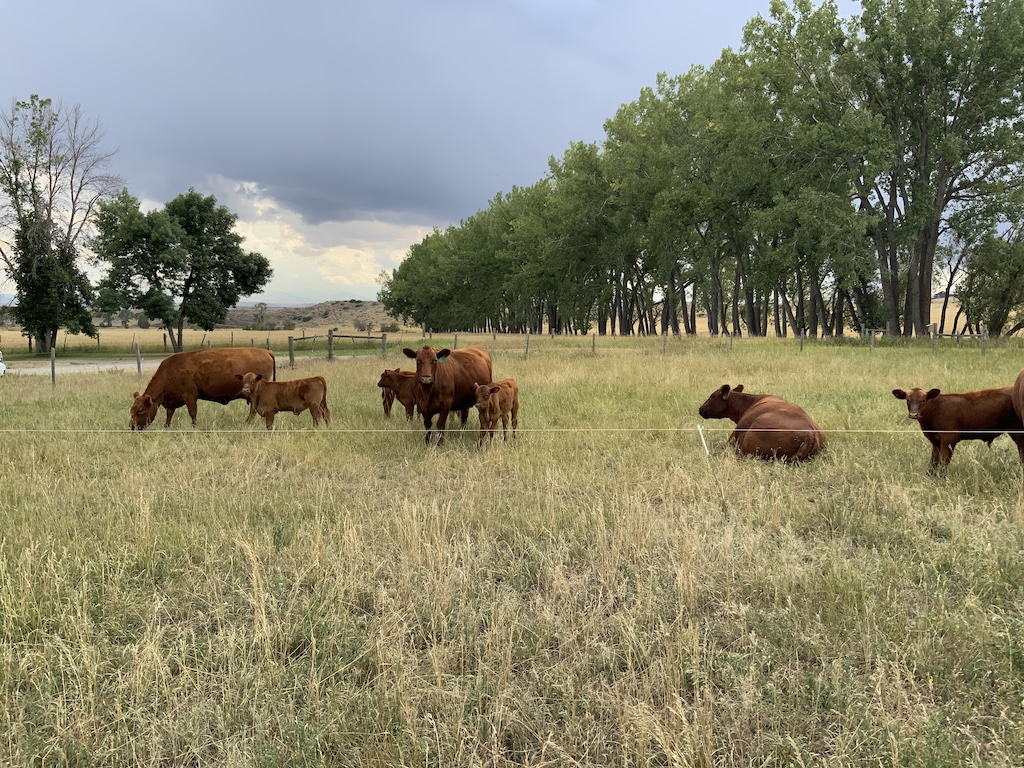
Cattle grazing in temporary electric fence paddock used for controlled seed dispersal
- Seeding occurred September 2022, June 2023, and Spring/Summer 2024 based on Western SARE FW20-358 timing recommendations.
Natural Fertilization and Cattle Activity Benefits:
- Manure provided ideal germination conditions: moisture retention, nutrient availability, protection from wind and predation, and optimal soil contact.
- Hoof action mixed seeds into soil and trampling created microsite variations.
- Grazing pressure reduced competition from existing vegetation.
- Natural timing aligned with cattle movement patterns.
Expected Outcomes: Based on literature review, anticipated survival rates through cattle digestion:
- Hard-seeded legumes: Natural scarification may benefit germination
- Grass species: Variable survival expected
- Small-seeded forbs: Lower survival rates may require higher seeding rates
Digestive Process Benefits:
-
Scarification of hard seed coats improved germination
-
Acid treatment breaks dormancy in some species
-
Innoculation with beneficial microorganisms
-
Natural timing with moisture and temperature
-
Seed Mixes:
The seed mixes were carefully designed to provide maximum benefit to both pollinators and livestock while surviving the endozoochory dispersal process. Each species was selected based on specific criteria:
Selection Criteria:
- Pollinator value: High nectar and pollen production
- Grazing compatibility: Palatable and nutritious for cattle
- Local adaptation: Native or well-adapted to Montana conditions
- Seed durability: Ability to survive cattle digestion
- Germination success: Effective establishment in rangeland conditions
- Seasonal diversity: Extended blooming periods for continuous pollinator support
Year 1 (2022) - Foundation Species:
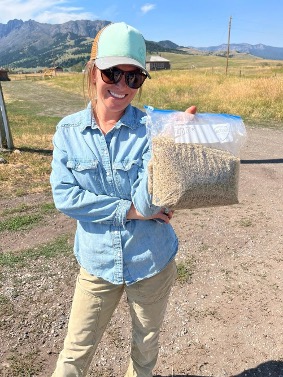
Malou Anderson with pollinator seed mix containing native grasses and forbs
Bluebunch Wheatgrass (Pseudoroegneria spicata) - 25%
- Cool-season native perennial bunchgrass
- Excellent soil stabilization and erosion control
- High-quality forage for livestock
- Early season growth and establishment
Purple Prairie Clover (Dalea purpurea) - 10%
- Perennial legume wildflower
- Exceptional pollinator plant with dense flower heads
- Nitrogen fixation benefits soil health
- Drought-tolerant once established
Joseph’s Idaho Fescue (Festuca idahoensis ‘Joseph’) - 10%
- Cool-season native perennial bunchgrass
- Excellent wildlife and livestock forage
- Tolerates heavy grazing pressure
- Long-lived with deep root system
Stillwater Prairie Coneflower (Ratibida columnifera) - 5%
- Late-season native perennial forb
- Extended blooming period (July-September)
- Important late-season pollinator resource
- Distinctive cone-shaped flowers
Year 2 (2023) - Expanded Mix
We added three additional species in the second year to enhance pollinator diversity:
Cicer Milkvetch (Astragalus cicer) - 37.5%
- Perennial legume wildflower
- Exceptional nitrogen fixation capability
- Long blooming period with abundant flowers
- High protein forage value
Birdsfoot Trefoil (Lotus corniculatus) - 10%
- Perennial legume wildflower
- Bright yellow flowers attract diverse pollinators
- Non-bloating legume safe for cattle
- Tolerates poor soils and drainage
Rocky Mountain Beeplant (Cleome serulata) - 2.5%
- Annual flowering forb
- Specifically selected for native bee attraction
- Traditional Native American food plant
- Self-seeding annual providing long-term benefit
Scientific Rationale:
Legume Dominance Strategy Nearly 60% of our final mix consisted of legumes, providing:
- Nitrogen fixation to improve soil fertility
- High protein content beneficial for cattle nutrition
- Extended blooming periods for sustained pollinator support
- Root nodulation enhancing soil biological activity
Grass-Forb Balance The remaining 40% consisted of native grasses and forbs:
- Structural diversity in plant communities
- Varied bloom timing from early to late season
- Different growth forms creating habitat complexity
- Soil stabilization through diverse root systems
Pollinator Optimization Species were selected to provide:
- Continuous bloom succession from June through September
- Diverse flower types attracting different pollinator species
- Native plant preferences supporting indigenous bee populations
- Abundant nectar/pollen resources during critical periods
Detailed seed information sheets: 2022 Seed Info Sheet | 2023 Updated Seed Mix
2. Soil Microbe Health Promotion via Bale Grazing
Objective: Test whether bale grazing in winter, combined with endozoochory, can enhance soil microbial communities, organic matter, and moisture retention.
Methods:
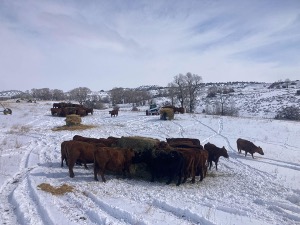
Bale grazing setup at Keewaydin Ranch showing strategic winter feeding distribution
Bale grazing is a winter feeding strategy where hay bales are strategically placed across pastures and cattle are allowed to feed directly from them in the field. Rather than feeding hay in a centralized location, bales are distributed to maximize the fertilization and trampling benefits across the landscape. In our case, bale grazing complemented our strategy of increasing biodiversity and soil health at the partner ranches to increase their chances of germinating pollinator friendly plants.
Soil Health Objectives:
Bale grazing supported our research goals by:
- Increasing biomass cover and organic matter across paddocks
- Improving moisture retention in soil through residual hay and manure
- Building soil microbe communities through organic matter inputs
- Creating diverse microhabitats for seed germination
Integration with Seed Dispersal:
Bale grazing complemented our seed distribution strategy:
- Enhanced germination conditions for dispersed seeds
- Reduced bare ground which can inhibit establishment
- Increased soil biological activity supporting plant growth
- Improved water infiltration and retention
Implementation:
- Conducted bale grazing in January–February 2023 and 2024 (winter months when pastures are dormant, before spring growing season to maximize benefit).
- Strategically placed bales within research paddocks across pastures to encourage uniform manure and litter distribution.
- Even distribution to avoid overuse of any area, considering topography and natural water flow, with appropriate distance from water sources to prevent contamination.
- Allowed natural cattle behavior in site selection, with gradual bale exposure to prevent waste and monitoring of consumption.
- Monitored ecological and soil health indicators using the Savory Short Term Ecological Outcome Verification (EOV) methodology.
This technique represents a practical example of how traditional ranching methods can be optimized to support ecological restoration goals while maintaining operational efficiency.
3. Rangeland Health Monitoring
Objective: Measure changes in ecological condition of treatment areas using standardized, outcomes-based monitoring.
Methods:
As part of the Buzz on the Range project, we applied the Ecological Outcome Verification (EOV) Short Term Monitoring (STM) methodology at each site per ranch, across all ranches in the study. Rather than conducting formal verification, we used the STM framework to generate consistent, comparable data on rangeland health across sites. STM focuses on leading indicators—rapidly responsive measures of ecosystem function—which are assessed annually using a regionally adapted Evaluation Matrix.
Why EOV STM?
The STM protocol offers a science-based approach to track short-term ecological change. It evaluates the condition and trend of critical ecosystem processes:
- Water cycle: infiltration, runoff, and soil cover
- Mineral cycle: decomposition of plant and animal matter
- Energy flow: green plant productivity and cover
- Community dynamics: plant species composition and ground cover structure
By using a standardized set of indicators, we could assess the effects of our management interventions across varied ecological contexts.
Monitoring Design:
- Site selection: One representative ecological site per ranch
- Annual assessment: Conducted during the growing season
- Observer method: Visual field scoring following STM protocols; no digital platform used
- Consistency: All observations guided by the EOV Evaluation Matrix for our ecoregion
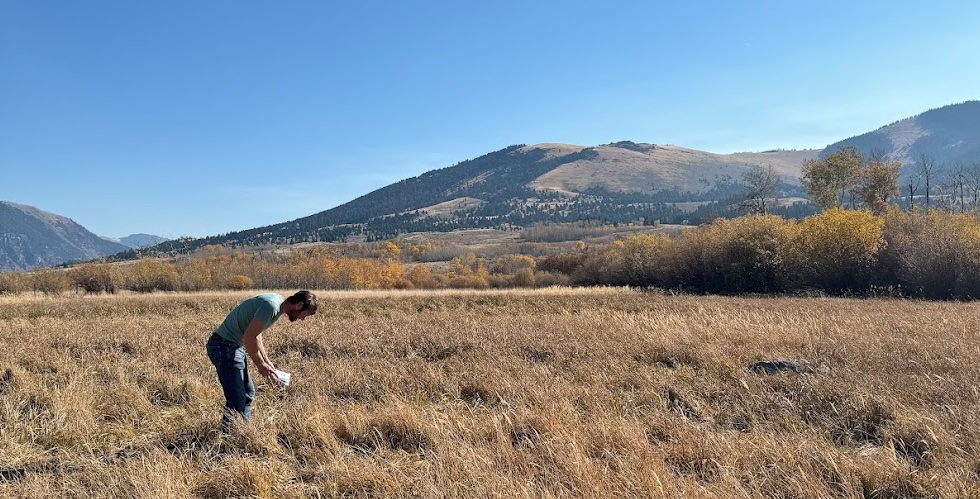
Field monitoring using Ecological Outcome Verification (EOV) Short Term Monitoring protocols
Ecological Indicators Assessed:
Below is the complete list of STM indicators we used, following EOV methodology. Each indicator was visually assessed and scored based on descriptive criteria reflecting the function and health of the site.
| Indicator | Description |
|---|---|
| Live Canopy Abundance | Total green plant cover actively photosynthesizing |
| Litter Abundance | Quantity of dead plant material covering the soil |
| Litter Decomposition | Degree to which litter is breaking down and integrating into the soil |
| Dung Decomposition | Signs of dung breakdown by insects, microbes, and other biological activity |
| Bare Soil | Percentage of unprotected, exposed soil surface |
| Soil Capping | Presence of hard surface crusts that inhibit infiltration and germination |
| Wind Erosion | Evidence of soil loss or deposition caused by wind |
| Water Erosion | Signs of sheet, rill, or gully erosion from rainfall and runoff |
| Warm Season Grasses | Presence and condition of warm-season perennial grasses |
| Cool Season Grasses | Presence and condition of cool-season perennial grasses |
| Forbs and Legumes | Diversity, vigor, and density of flowering herbs and nitrogen fixers |
| Trees and Shrubs | Structure and density of woody vegetation (where contextually appropriate) |
| Desirable Species | Abundance and health of species identified as desirable for the context |
| Undesirable Species | Presence of weedy, invasive, or management-indicating species |
| Living Organisms | Signs of life at soil surface (e.g. insects, earthworms, crusts, fungi) |
These indicators provided a comprehensive snapshot of ecosystem function at each site and year. By repeating measurements over time, we could:
- Identify signs of ecological stress or degradation early
- Detect progress in regeneration from management interventions
- Inform decisions about grazing, rest, or seeding strategies
Application Notes:
This project adapted the EOV STM methodology for research purposes:
- EOV-aligned indicators and scoring used
- No certified monitors involved
- No data uploaded to Savory Institute platform
- One monitoring site per ranch (not full-farm stratified sampling)
The STM framework provided a practical and reliable way to monitor ecosystem outcomes in a field-based, non-commercial research context.
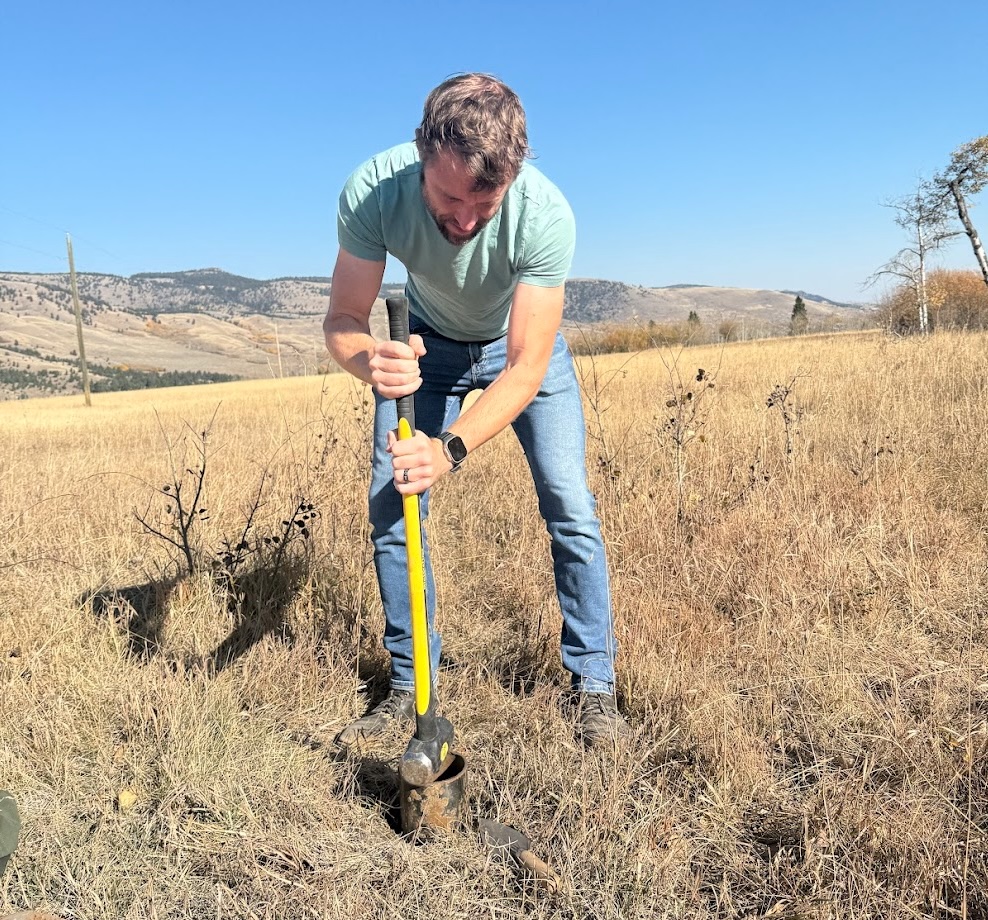
Installing water infiltration ring to measure soil health and water cycle function
- Incorporated plant surveys following Savory Long Term EOV protocols.
- 2022: Completed baselines for three ranches; Milk Maid Meats and West Creek Ranch delayed due to Yellowstone River flooding.
- 2023: All five ranches completed full baseline and follow-up assessments.
- 2024: Repeated 2023 methods; documented indicators with photographs. West Creek Ranch excluded due to non-participation.
4. Pollinator Monitoring
Objective: Monitor bee species richness and diversity in treatment vs. control plots.
Methods:
Bee surveys in the Buzz on the Range project were conducted using a combination of blue vane traps and walk-around surveys in both control and treatment areas at each ranch. This practical approach works well in working landscapes where flexibility is needed.
Key Methods Used:
Blue Vane Traps:
- Blue vane traps were set out in survey areas to passively capture a wide range of bee species, especially solitary bees and less conspicuous pollinators.
- Traps were typically left out during peak bee activity and checked regularly.
- Captured specimens were carefully collected for later identification.
Walk-Around Visual Surveys & Hand Netting:
- Surveyors walked systematically through both control and treatment plots, visually observing bees in flight and on flowers.
- Bees seen foraging were, when possible, captured using hand nets for close inspection and identification.
- Observers paused at flower-rich areas to maximize species detection and record bee/flower associations.
Lab Identification for Captured Bees:
- Bees that could not be confidently identified in the field or from photos were preserved and sent to entomology labs for positive identification.
- This ensured accurate, high-confidence species lists for each ranch.
Paired Control and Treatment Sites:
- Control sites: Represented baseline management, with no pollinator-focused interventions.
- Treatment sites: Managed with pollinator seed mixes, grazing adjustments, or other enhancements to benefit pollinators.
Bee/Flower Association Tracking:
- When possible, the bee species and the specific flower species visited were recorded.
- These associations help identify key forage plants and evaluate habitat interventions.
Identification & Data Handling:
-
Bees were identified to the lowest possible taxonomic level (species or genus), using field guides, expert lab ID, and photographs.
-
All observations included date, location, and flower species when possible.
-
Results are summarized as species richness (total bee species recorded) and composition (types of bees present) for each ranch and management treatment.
-
Partnered with Sarah Red-Laird (Bee Girl Organization, now called Bee Regenerative) for pollinator surveys at producer sites in 2022–2024.
-
Used blue vane traps and detailed species identification.
-
Created an iNaturalist project (iNaturalist Observation Records) to catalog pollinator-supportive plant species observed on site.
5. Rangeland Management Tools Testing (OpenTEAM Collaboration)
Objective: Evaluate the potential to integrate pollinator health indicators into ecological outcome tracking platforms.
Methods:
- Collected management and monitoring data using FarmOS.
- Provided usability feedback to developers of FarmOS during their development calls.
- Chose not to use SurveyStack due to offline limitations; LandPKS was not used as Savory methodology was a better fit.
6. Business Plan Impact Evaluation
Objective: Explore how research outcomes could inform a pollinator-focused ranch business plan.
Methods:
- Conducted end-of-project feasibility assessment with the research team and producer partners.
- Planned to include input on materials, labor, potential cost savings, soil health benefits, beekeeper partnerships, and co-benefits.
7. Data Management
Methods:
- Stored project data in FarmOS for consistency and centralized access.
- Used iNaturalist to maintain a publicly viewable inventory of pollinator-supportive plant species.
- Analyzed monitoring data annually to identify trends in ecological health, pollinator diversity, and plant community composition.
Summary of Key Findings (2022–2024)
After three years of implementation and monitoring, the project found that while cattle-mediated seed dispersal was not effective for establishing target pollinator plants, adaptive grazing and bale grazing significantly improved ecological health and pollinator diversity.
1. Pollinator Promotion via Endozoochory
Seed Establishment Results:
Over three years of monitoring, none of our seven seeded species established in any test pastures at any partner ranches:
-
Bluebunch Wheatgrass (Pseudoroegneria spicata)
-
Purple Prairie Clover (Dalea purpurea) — possible exception at Keewaydin Ranch
-
Idaho Fescue (Festuca idahoensis ‘Joseph’)
-
Prairie Coneflower (Ratibida columnifera)
-
Cicer Milkvetch (Astragalus cicer)
-
Birdsfoot Trefoil (Lotus corniculatus)
-
Rocky Mountain Beeplant (Cleome serulata)
-
0% establishment of all seven target species across sites (possible exception of Dalea purpurea at Keewaydin Ranch).
-
Seeds were observed in manure annually but did not survive digestion to germination.
Why Establishment Did Not Occur:
- Seeds may still be waiting in the soil for just the right year.
- Establishment of some perennials could simply take longer than our study window.
- Weather, timing, and the limits of this method all play a part.
2. Soil Microbe Health Promotion via Bale Grazing and Intensive Planned Grazing
- Increased litter cover, organic matter, and moisture retention observed during monitoring periods, contributing to improved ecological health scores.
3. Rangeland Health Monitoring
Ecological health was assessed using the Savory Short Term Monitoring methodology, combined with water infiltration tests, plant species inventory along fixed transects, and photo documentation at fixed points. Each ranch was evaluated at the same sites over multiple years. Scores were based on functional group presence, soil cover, soil biology, and other indicators.
Multi-Year Ecological Health Scores and Highlights:
| Ranch | 2022 Score | 2023 Score | 2024 Score | Net Change | Key Outcomes |
|---|---|---|---|---|---|
| Anderson Ranch | 5 | 55 | 40 | +35 | Consistent improvement, strong ground cover |
| Barney Creek Livestock | -45 | -40 | -10 | +35 | Recovery from a tough baseline, more diversity |
| Keeywadin Ranch | -10 | 5 | 60 | +70 | Dramatic gains, pollinator clover established |
| Milk Maid Meats | — | -35 | 30 | +65 | Record 1-year improvement (irrigated pasture) |
Major Findings:
- Every ranch improved
- All ranches improved ecological health scores between +35 and +70 points.
- All sites saw positive change, even where starting conditions were poor.
- The regenerative management and seed-through-cattle approach increased functional group diversity, ground cover, and signs of soil health.
- Gains attributed to improved grazing management rather than seed establishment.
- Keewaydin Ranch stands out
- Achieved a remarkable +70-point gain over three years
- Pollinator clover successfully established in the transect, a rare direct result
- Milk Maid Meats—explosive gains with irrigation
- 65-point leap in one year (from -35 to +30)
- Tufted Hairgrass became dominant, ground cover improved dramatically
- Water infiltration slowed in saturated soil (likely an irrigation artifact, not a sign of degradation)
- Anderson & Barney Creek—gradual, hard-won progress
- Anderson improved 35 points and stabilized, even in the absence of visible seeded pollinator species
- Barney Creek improved 35 points from a severely degraded baseline, with new native species showing up, though pollinator seed mix species have not yet established
- Pollinator species
- Pollinator-promoting species establishment was limited in most sites, with the exception of clover at Keewaydin Ranch
Why do scores jump or lag? Rangelands are dynamic. Year-to-year weather, monitoring timing, and grazing history all play a part. Even modest improvements in the Savory evaluation often mean substantial, long-term soil function gains.
4. Pollinator Monitoring
Bee monitoring results from the Buzz on the Range regenerative ranch project tracked native and managed bee populations across participating ranches to measure the impact of pollinator-focused management and habitat interventions from 2022–2024.
Why Bees? Bees are vital for crop pollination, healthy wild plant communities, and resilient food systems. They are sensitive indicators of land management, and their presence (or absence) is a sign of ecological function and habitat quality.
Bee Species Richness by Ranch and Treatment (2024):
| Ranch | Control Plot (species) | Treatment Plot (species) | Notable Highlights |
|---|---|---|---|
| Anderson Ranch | 15 | 38 | Highest gain, rare bumblebees and leafcutter bees, broadest range |
| Barney Creek (Deep Ck) | 13 | 20 | Western bumblebee present in both, increase in diversity |
| Keewaydin Ranch | 16 | 9 | High native bee richness in control, unique bumblebee finds |
| Milk Maid Meats | 2 | 9 | Major gain in treated plots; sweat bees, bumble bees appeared |
| West Creek Ranch | 6 | 8 | Increase in cavity-nesters and specialist bees |
Major Findings:
- Bee diversity increased in most project management sites
- Bee species richness was up to 153% better in managed plots.
- Anderson Ranch: Treatment plots supported the greatest bee diversity (38 species, including uncommon bumblebees and leafcutter bees).
- Milk Maid Meats: Only 2 species in controls; 9 species recorded in treatment, including sweat bees and bumblebees.
- Barney Creek: Notable jump from 13 to 20 species after intervention.
- West Creek: Slight increase and more cavity-nesting species after treatment.
- Unique and rare bees observed
- Rare and conservation-priority species documented, including Western Bumblebee (Bombus occidentalis), Silver-tailed Petalcutter Bee (Megachile montivaga), and Maine Blueberry Bee (Osmia atriventris).
- Western bumblebee (Bombus occidentalis): Detected at multiple ranches—a species of conservation concern.
- Silver-tailed Petalcutter Bee (Megachile montivaga): Rare in the region, observed at Anderson Ranch.
- Maine Blueberry Bee (Osmia atriventris): Found at West Creek—a pollinator usually associated with eastern North America.
- Native bee functional groups present
- Sweat bees (Lasioglossum, Agapostemon), bumblebees (Bombus), mason bees (Osmia), leafcutter bees (Megachile), and others found.
- Each group fills a unique ecological role and responds to different flowers and habitats.
- Flower and bee associations
- Diverse blooming plants (asters, clovers, goldenrod, gumweed, sainfoin, lupine) supported greater bee diversity.
- Management for continuous flowering and ground cover remains critical for sustaining native bee populations.
Sample Bee/Flower Association (Anderson Ranch):
| Bee Species | Flower Associations |
|---|---|
| Silver-tailed Petalcutter | Gumweed, sunflower, aster, goldenrod |
| Western bumblebee | Lupine, spirea, geranium, goldenrod |
| Bicolored striped sweat bee | Asteraceae, roses, strawberries |
Challenges and Next Steps:
-
Year-to-year variation: Bee populations naturally fluctuate with weather, landscape, and management changes.
-
Habitat establishment lag: Some seeded pollinator plants may require more years to support additional bee species.
-
Further monitoring: More years of data and targeted habitat efforts will clarify long-term trends.
-
It is our opinion that animal impact and habitat creation helped bee populations be more robust at the control plots, regardless of whether the seeded species were observed. However, the “error bars” on bee inventory are quite large and may be a result of regional year-to-year or seasonal variations as well. It would be irresponsible to “conclude” scientifically that the bee population was aided with this project. But it’s promising and may warrant further study.
Reference: Buzz on the Range Final Bee Presentation
5. Existing Pollinator Plants Observed
Even if our seed experiment didn’t establish target species, there’s good news: our ranches already have a surprising variety of wildflowers and pollinator plants. Here’s a snapshot from our annual flowering plant inventory, documented during summer peak bloom by our bee specialist, Sarah Red-Laird.
iNaturalist Observation Records
Most Frequently Observed Pollinator Plants:
| Observations | Common Name | Scientific Name |
|---|---|---|
| 6 | False London-Rocket | Sisymbrium loeselii |
| 4 | White Clover | Trifolium repens |
| 4 | Hairy False Goldenaster | Heterotheca villosa |
| 4 | Field Penny-Cress | Thlaspi arvense |
| 3 | Dandelions | Taraxacum spp. |
| 3 | Red Clover | Trifolium pratense |
| 3 | Common Yarrow | Achillea millefolium |
| 3 | Yellow Sweetclover | Melilotus officinalis |
Other pollinator-friendly plants spotted include: Alfalfa (Medicago sativa), Alsike Clover (Trifolium hybridum), Hoary Alyssum (Berteroa incana), Scarlet Globemallow (Sphaeralcea coccinea), Sainfoin (Onobrychis viciifolia), Silvery Lupine (Lupinus argenteus), Sticky Geranium (Geranium viscosissimum), and many more.
Key Takeaways:
- No seeded species established (yet), with one possible exception.
- Existing floral diversity is strong—lots of “bee food” already present.
- Baseline matters: This diversity supports pollinator communities and gives us a foundation to build on for future work.
- Negative results are still results: Sometimes, nature teaches us to try a new approach.
6. Rangeland Management Tools Testing
- FarmOS successfully used for data collection and tracking; feedback contributed to platform improvements.
- SurveyStack was not adopted due to offline limitations; LandPKS was not used.
7. Business Plan Impact Evaluation
- Determined insufficient evidence to produce a pollinator-focused business plan at this time.
8. Livestock Health
- No reported ill effects from seed mix consumption over three years.
- Normal weight gain and reproduction rates maintained.
9. Economic Analysis
- Grant funding: $55,990 (Western SARE)
- Equipment: $1,845.52 for solar chargers, electric fence materials (receipts on file)
- Seed: $1,727.33 (2022); $1,400 budgeted (2023) (receipts on file)
- Bale grazing: ~$500 per 1-ton bale delivered per producer
- ROI: Poor for seed dispersal method due to lack of establishment
Research Outcomes
This project tested the hypothesis that cattle could disperse and establish pollinator-friendly seeds via manure (endozoochory) across five Montana ranches from 2022–2024. The results were clear: while ecological health and pollinator diversity improved through adaptive grazing, no target species successfully established via this method. The following recommendations synthesize three years of research, field observations, and producer experience, with linked resources for replication or deeper study.
What Worked: Management Over Seeding
- Adaptive Grazing Management Improves Ecosystem Health
- All participating ranches improved Savory Short Term Monitoring ecological health scores by +35 to +70 points.
- Improvements occurred without successful seed establishment, indicating that management changes alone can drive ecological gains.
- Electric fencing and controlled rotation were key in managing grazing intensity.
- Recommendation: Focus resources on optimizing grazing management practices before investing in expensive seeding.
- Linked Resources: Overview & Grazing Plan for Producer Partners
- Native Plant Communities Respond to Better Management
- Existing pollinator plants flourished under improved management, as documented in Buzz on the Range Final Bee Presentation.
- Native and naturalized species provided abundant pollinator forage without reseeding.
- Recommendation: Inventory and manage existing plant communities before attempting introductions.
- Bee Diversity Increases with Overall Rangeland Health
- Bee species richness was up to 153% increase in managed plots.
- Rare and conservation-concern species were documented, including Western Bumblebee and Silver-tailed Petalcutter Bee.
- Recommendation: Enhance overall ecosystem health to support pollinators, rather than focusing solely on introducing specific plants.
- Linked Resource: Buzz on the Range Final Bee Presentation
What Didn’t Work: Cattle-Mediated Seed Dispersal
- Endozoochory Not Viable for Selected Species
- 0% establishment for all seven target species over three years (possible Dalea purpurea exception at Keewaydin Ranch).
- Seeds observed in manure each year but appeared non-viable post-digestion.
- Recommendation: Do not rely on this method for establishing these specific pollinator plants.
- Timing and Method Limitations
- Favorable germination conditions in 2023 did not result in establishment.
- Method may not align with biological requirements of perennial forbs and grasses.
- Recommendation: Consider alternative methods such as direct seeding or transplanting.
Recommendations for Future Research
- Investigate Seed Viability Post-Digestion
- Conduct controlled germination tests on seeds collected from manure.
- Compare across plant species and test pre-treatment methods to improve survival.
- Long-Term Monitoring
- Continue site monitoring beyond three years to detect delayed establishment.
- Document any volunteer seedlings in subsequent years.
- Alternative Establishment Methods
- Compare direct seeding, interseeding, and transplanting in managed paddocks.
- Evaluate cost-effectiveness relative to adaptive grazing.
- Focus on Enhancement Rather Than Introduction
- Research management strategies that favor existing pollinator-friendly plants.
- Study effects of grazing timing and intensity on flowering plant abundance.
Economic Considerations
- Cost-Benefit Analysis
- Improved grazing management achieved ecological benefits without seed costs.
- Electric fencing provided multi-year benefits beyond research needs.
- Recommendation: Prioritize investments in management infrastructure over repeated seeding attempts.
- Producer Adoption
- Producers more readily adopted simple, low-cost management adjustments.
- Bale grazing offered both feeding and soil improvement benefits.
- Recommendation: Promote practices that have multiple benefits and clear economic returns.
Contribution to Agricultural Sustainability
This project demonstrates that:
- Adaptive grazing management can achieve measurable ecological improvements in the Western U.S. without costly seeding.
- Honest reporting of negative results prevents wasted resources and guides future investment.
- Existing biodiversity can be leveraged and enhanced through thoughtful, site-specific management.
- Long-term, producer-researcher collaboration yields actionable and replicable insights.
Final Recommendations
- For Producers: Focus on improving grazing management before attempting seed establishment.
- For Researchers: Test multiple establishment methods and incorporate longer monitoring periods.
- For Funders: Support transparent reporting of both successful and unsuccessful strategies.
- For Extension: Promote holistic, systems-based management rather than single-solution interventions.
This research underscores the value of adaptive management, long-term ecological monitoring, and transparent reporting in advancing sustainable agriculture in the Western U.S.
Education and Outreach
Participation Summary:
The following details our education and outreach throughout the project. We have updated it by year while retaining intention details from the grant application.
Progress Reports
Learning Section of Buzz on the Range Website - for 2024, we published a large set of the learning on the Buzz on the Range project site. We also published much of the learning that was recorded on video on our YouTube channel (linked to from the website).
2023 Progress Report - an updated presentation about 2023 with visuals is presented here.
2022 Progress Report - a highlight presentation about 2022 with visuals is presented here.
Overall Objectives
Participating producers will learn how the soil health and pollinator activity of their ranges vary within their own ranches and how they compare to other ranges in their ecosystem and region. They will see how the management of rangeland can influence soil health and how improved soil health might impact the ecosystem and pollinator habitats. Participating partners and community members will learn many of the same things as they participate in various aspects of the work.
Methods
Our grant proposal includes education and outreach in 3 clear ways:
- Workshops each year touching on various aspects of the project and impacts
- Public/Rancher awareness campaigns such as “Soil Your Undies”
- Opportunity for producers and students to learn at research in action field days
- Documenting and sharing the outputs of the project widely
2022 Education and Outreach
Workshop 1 Details - April 29, 2022 - Soil Health and “Soil your Undies” Workshop - West Creek Ranch
Outreach
We invited producers and ranchers from across Southwest Montana to join our workshop. Partner workshop development and support: Stacey Barta (The Montana DNRC), Western Sustainability Exchange. Target audience:
- Project producers,
- producers in our region,
- partner organizations/programs, the
- Yellowstone Valley Ecosystem communities
We used our Project partner organizations email lists and event sites (it was held at West Creek Ranch), and word of mouth from participating producers. There are fantastic marketing tools from Oregon’s NRCS that we used to start our “Soil your undies” marketing in our area. The flyer for the event is here.
Event
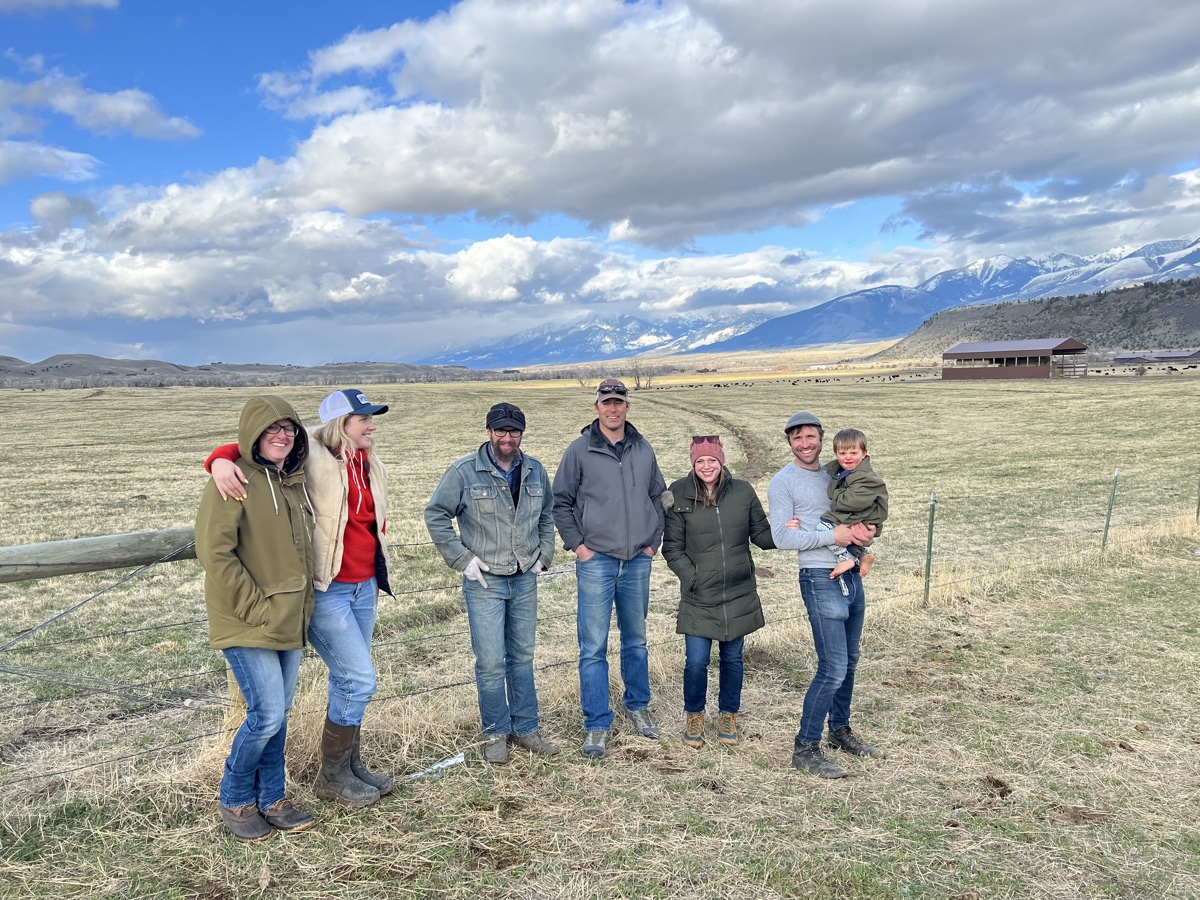
Buzz on the Range project team and producer partners at West Creek Ranch workshop, April 2022
- See slides 9-10 of the update presentation for visuals of the day.
- We had 8 producer attendees, a DNRC representative, an NRCS soil health specialist, the Executive Director from Western Sustainability Exchange and the Conservation Director from AMB West in attendance.
- Participants learned or reviewed the five principles of soil health, ways to measure soil health, and how to improve the quality of their soil with tools they may already own. The workshop also covered microbiological activity, health, and seeds in mineral–planting seeds for bees/bovine.
- Marni Thompson, the NRCS Soil health Specialist in Montana did a wonderful lesson and demonstration on: Visual Soil Assessment and Discussion of Soil Health
- Chris Mehus from Western Sustainability Exchange and We Are For the Land representatives did a demonstration on how to bury undies on rangeland. This kicked off our “Soil Your Undies” campaign for 2022.
2022 Soil Your Undies Campaign
The Buzz on the Range project incorporated the “Soil Your Undies” experiment as an engaging way to demonstrate soil health across our partner ranches. This simple test reveals whether your soil’s microbiology is active and doing what it’s supposed to do.
What is Soil Your Undies?

Soil Your Undies citizen science experiment to test soil biological activity
Soil Your Undies is a citizen science initiative that originated in NRCS Oregon and has been used as a fun, educational tool to test soil health. The concept came to our project when Meagan Lannan learned about it from a colleague in New Zealand.
The experiment is brilliantly simple: bury cotton underwear in your soil and let the microbes do their work. The more the underwear decomposes, the healthier and more biologically active your soil is.
How to Conduct the Test:
- Get a pair of 100% cotton underwear - They must be cotton because that’s what soil microbes can digest
- Bury them to the waistline - About 3 inches deep in the soil
- Mark the spot - So you can find them again!
- Wait 90+ days - The exact time depends on your soil’s microbiology activity
- Dig them up - And see what’s left!
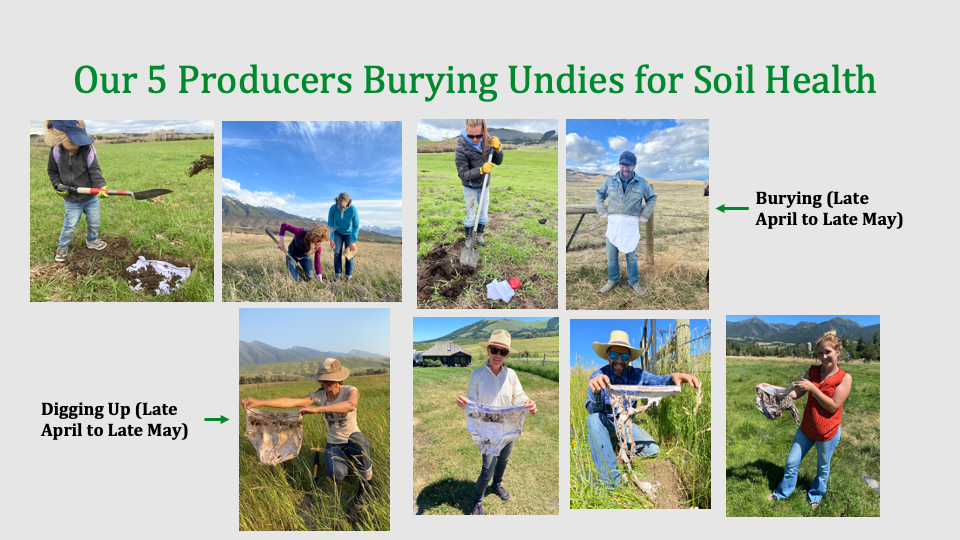
Producer partners burying cotton underwear to test soil microbial activity
The Science Behind It:
Healthy soil contains billions of microbes - in fact, one teaspoon of healthy soil contains more microbes than there are people on the planet. These microorganisms:
- Break down organic matter like cotton
- Help soil resist erosion
- Cycle nutrients
- Store water
- Support overall ecosystem health
When your soil is biologically active, the microbes will literally eat the cotton underwear. The more decomposed the underwear, the more active your soil biology.
Our Results:
Across our partner ranches, we saw varying levels of decomposition that reflected the biological activity in different soils:
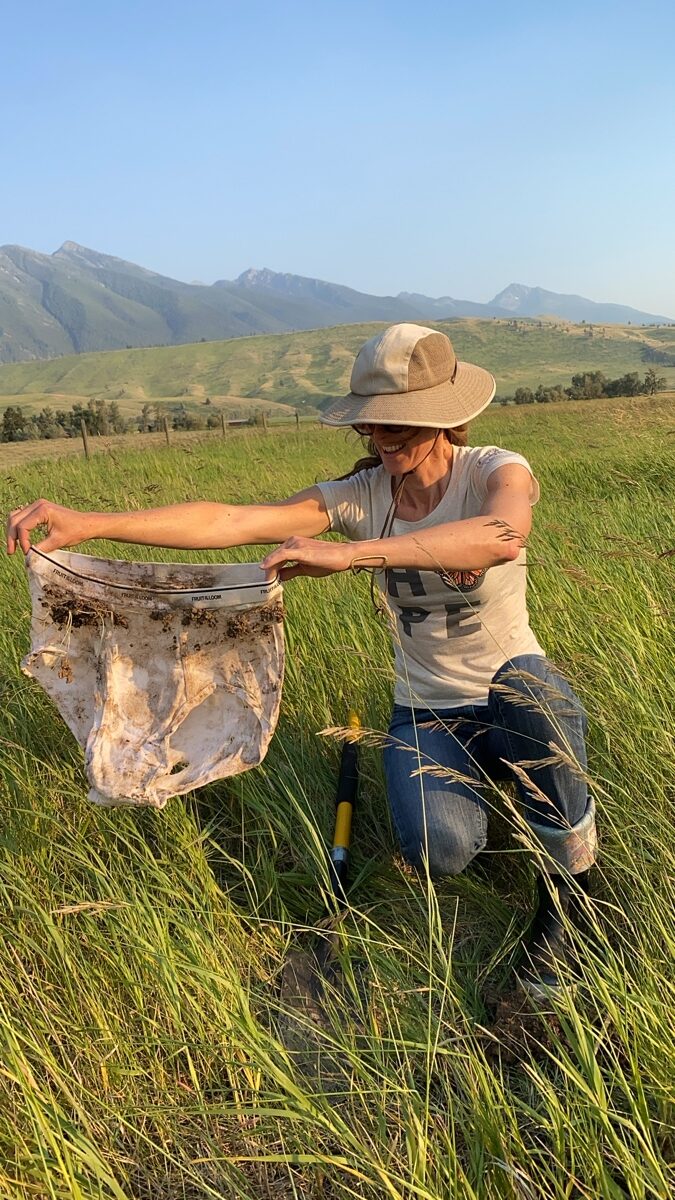
Partially decomposed underwear from Barney Creek Ranch showing degraded soil biology
- Barney Creek Ranch - Lara Birkes discovered partially decomposed underwear, indicating degraded soil biology. (This matched our findings from our ecological monitoring!)
- Anderson Ranch - Malou Anderson’s results showed healthy microbial activity
- Milk Maid Meats - Lily Andersen found good decomposition rates.
- Keewaydin Ranch - Alex Blake and his family found good decomposition rates.
- West Creek Ranch - Teo Abbruzzese found great decomposition rates, with the undies being almost completely gone in his irrigated fenceline soil.
Educational Impact:
Working with Western SARE, we developed a comprehensive toolkit that allows anyone to conduct this experiment - whether it’s a 4-H Club, FFA chapter, or elementary school. The visual nature of the results makes it an excellent educational tool for all ages.
The experiment provides a “quick, fast, and dirty way” to assess whether your soil microbiology is sound, making soil health concepts accessible and engaging for the broader community.
We invited our producers in our region as well as interested community members to “Soil Their Undies.” Here is the flyer we created. We also created a landing page on our website for them to report their progress. This challenge encourages participants to “plant” cotton underwear and then dig them back up 60/90 days later to check on the microbial activity in the soil. While this is just an experiment just for fun, it gets people thinking about what their microbes are up to and how their management style influences how quickly they can eat their undies? We started a social media campaign on Instagram and Facebook encouraging others and workshop attendees to show us their “Soil your Undies” project. We checked back in 90 days on people who have joined the campaign and showed them the results of the buried underwear from the workshop site and encouraged them to share their photos.
2022 SUCCESS STORY: Even more Soil Your Undies - A BONUS WORKSHOP and serious awareness at the Livingston Farmers Market.
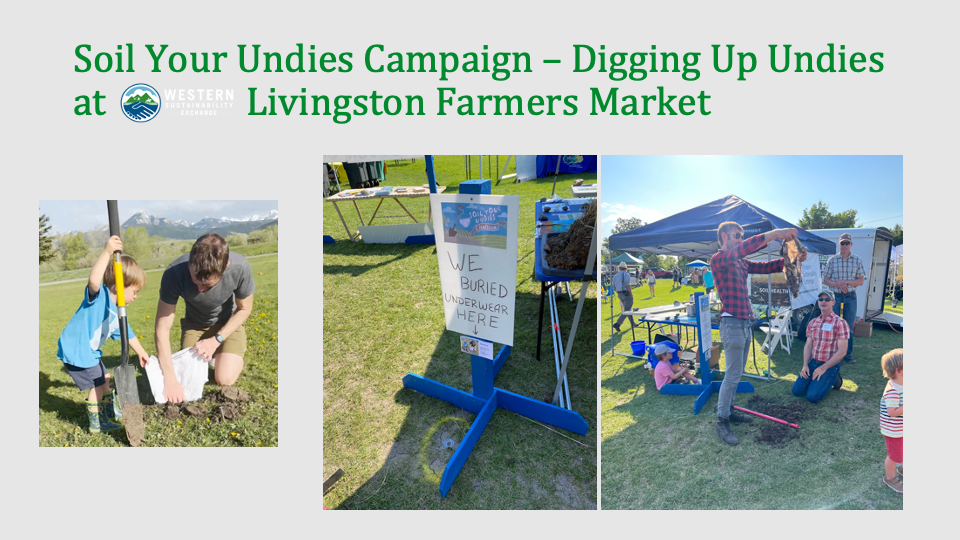
Community soil health demonstration at Livingston Farmers Market, July 2022
We were so inspired by the Soil Your Undies potential that, with fantastic in-kind support from Western Sustainability Exchange and Marni Thompson at NRCS, we did a soil health demonstration day at Miles Park in Livingston Montana that was well attended. We even put out a press release about it. We buried undies in Miles Park and dug them up on the soil health day on July 20th, 2022. See slides 12-13 on the project update presentation to get a sense of how well regarded, attended, and successful the day was.
2023 Education and Outreach
Expansion into 2 workshops
We had two main educational activities for our producers this year. Our original project proposal included only 1 workshop in 2023, but we had the distinct luck to have a fantastic partner in BGO as pollinator experts. We decided to include an ADDITIONAL workshop for our producers detailing just the pollinator aspect of their ranches. More details about that below.
Curriculum Shuffle
In addition to ADDING significant curriculum around pollinators from our expert partner. We also felt that a workshop centered around native grasses/plant surveys/water infiltration/bale grazing would be low-value-add for our producer partners since they also had been actively doing those activities with us in the field. Therefore, we had an opportunity to provide a different, more engaging workshop based on a sister event that we’ll share details about below.
Workshop: Montana Rangeland Tour - July 6th, 2023
The DNRC Montana Range Land tour took the place of our initially planned summer 2023 workshop which was intended for our producers with a wide invitation for other producers in the area to attend. However, with DNRC hosting a workshop already at one of our producer’s (Barney Creek Livestock) locations we decided that we would be able to reach more producers by presenting as part of their workshop.
Initial grant application workshop objectives (for reference, changed per “Curriculum Shuffle” above)
Content/Objectives:
- We’ll share project updates and any progress notes on the project with all attendees.
- The workshop will focus on native grasses that are good for grazing livestock and for pollinators, how to conduct plant surveys and examples of common plants that are found in Montana rangeland.
- The workshop will also cover how to impact Water Infiltration and the what the benefits of Bale Grazing are and how to use this technique effectively.
Target audience:
- Project producers,
- Producers in our region,
- MSU students from partner organizations/programs,
- the Yellowstone Valley Ecosystem communities
Partner workshop development and support: Ted Nelson (NRCS), Rachel Frost (MSU DSRP), Chris Mehus (WSE), Stacey Barta (DNRC)
Curriculum for Montana Rangeland Tour
The attached schedule for the Montana Rangeland Tour includes the details of the day. Note inclusion of Buzz on the Range. Major touchpoints:
- Soil health demonstration from world-renowned Nicole Masters, including a trench and microbiome discussion
- Pasture tours of Pete and Meagan (Barney Creek Livestock) locales including in-depths on electric fence and water management to support daily moves
Buzz on the Range Section of the Montana Range Tour Days
- Stacey Barta, our DNRC grant partner, enthusiastically included almost an hour for us to share the details of this project and objectives.
- Barney Creek Livestock producer, Meagan Lannan led the conversation about Buzz on the Range. Meagan shared overall about the project, the grazing protocol producers were using as well as the native seed mix involved.
- Lara Birkes, also shared about how the protocol has impacted her land which was previously heavily sprayed, un-grazed for a time, and lacked pollinator promoting plants.
- Buzz on the Range’s Fiscal Sponsor, Western Sustainability Exchange’s (WSE) then Program Director now Executive Director, Chris Mehus supported Meagan in talking about the project and connected how this work has inspired educational efforts in WSE’s programming. More on that in the impacts/outcome section.
- Michael DeChellis shared about how this work was supported by a Western SARE grant and encouraged attendees to come up with innovative producer partnerships for consideration by Western SARE for their grant goals.
Attendees
The workshop was WIDELY attended by all of those on the Rangeland Tour (estimated 40+ attendees!) Project producers Milk Maid Meats, Blake Ranch, and Malou Anderson were able to attend the workshop. Barney Creek Livestock has an additional project site and the landowner, Lara Birkes was in attendance to share her experience being part of the research protocol. Our 5th producer, West Creek Ranch, did not attend.
Workshop: Buzz on the Range Pollinator Surveys, Findings, and Pollinator Insights by Bee Girl Organization’s Sarah Red-Laird - December 11th, 2023
The second educational effort came from Sarah Red-Laird, Executive Director of the Bee Girl Organization. Last summer and this summer, she acted as our main pollinator research partner. She held a session with our producers to share with them all that she learned when surveying their fields. All 4 participating producers this year were able to attend this session. Sarah shared why there was a lack of complete bee data, shared preliminary findings, and demonstrated use of iNaturalist pages, where she was hosting her research. She also discussed methods for analyzing vegetation and bee populations. She also shared a powerful story about a bee death during her measurements on a producer’s land that really put the cost of spraying into focus from a pollinator perspective. Details of her presentation are in the update document here.
BONUS Education Activity: Soil Your Undies for ANOTHER YEAR!
We really wanted to highlight a successful continuation that came from our initial grant-funded Soil Your Undies campaign last year. At that time, we partnered with WSE to host a Soil Your Undies Campaign, which was met with great interest and success. While we weren’t able to continue this activity under this grant for this particular activity, WSE in 2023 did a social media campaign to encourage folks around Montana to Soil their Undies. They created some MT specific materials that they shared with their networks. In an email about this impact, Chris Mehus (project partner and ED of Western Sustainability Exchange) said: “Looks like our Western SARE Soil Your Undies activity continues to thrive and expand beyond our expectations! Last year, several groups, most notably Yellowstone County Extension and 4H used the concept for a large educational push that had tremendous reach through their youth program. From the forwarded email here, the MT Soil Health Week collaborative is using it this year as a major part of their outreach and programming!”
2024 Education and Outreach
Workshop Title: Buzz on Your Range: Discover the Benefits of Leasing Your Land for Grazing Date and Location: October 9, 2024 | MSU Extension Office, Livingston, MT Audience: Private landowners, leaseholders, small-acreage managers, conservation-minded land stewards
Links to videos from the workshop:
- Centering Visualization for Cows and Bees with Meagan Lannan
- Soil Your Undies Introduction from Meagan Lannan
- Grazing for Values with Jackie Pondolfino
- Montana Audubon Ranching Program with Christian Meny
- Adaptive Grazing and Leasing for Ecosystem Services Panel
- Platform for Grazers and Landowners to Connect - by Holly Stoltz with WSE
Educational Objectives Addressed:
-
Increase awareness of the ecological and economic benefits of grazing on private lands
-
Equip landowners with practical tools and considerations for leasing land for grazing
-
Build bridges between regenerative ranchers and landowners through shared learning
Methods:
-
In-person workshop (2.5 hours)
-
Panel format featuring regenerative ranchers (Barney Creek Livestock, Indreland Ranch) discussing lived experiences with leasing and land management
-
Expert presentations on grazing infrastructure, leasing logistics, and ecosystem benefits (e.g., Hayes Goosey on wildlife, Chris Mehus on the Mountain West Grazing Connection tool)
-
Hands-on Q&A and guided discussion encouraging audience participation and peer learning
-
Outreach tools included: community flyers, targeted email invitations, personal outreach to land trusts and landowner groups, and registration via Google Forms
Buzz on the Range Lessons
We created a k-12 lesson that can be used by agencies, educators, other producers based on our project. This has been shared with all participating producers and agencies and is available through the website to farm to school networks, 4H, and FFA. Lessons included opening focus question, learning objectives, lesson description, action steps, and a closing. Lesson Objectives:
- Increased understanding about the relationship of soil health, pollinator habitats, and grazing animals.
- Increased understanding about types of land management options available to support healthy ecosystems.
- Improved knowledge of ranching careers and the scope of work and their decision- making process.
- Improved awareness of current issues and challenges in agriculture.
Buzz on the Range Kids Book - Cows, Bees, and Blossoms
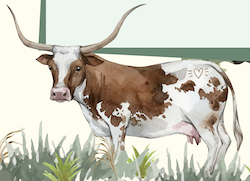
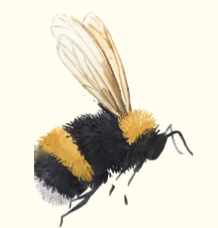
Lily the Cow and Biff the Bee, characters from the “Cows, Bees, and Blossoms” children’s book
We created a kids book to solicit contributions to the project from agencies, educators, and other producers.
Buzz on the Range Video series
We have completed and posted a visual story on YouTube showing what conducting this research actually looks like, with the goal of making it easy for others to replicate the process on their own. The video captures our workshops and demonstrates how we gather data at each producer site, including how we take measurements and record observations over time. This resource has been shared with our project producers and partners, who are encouraged to share it further. We will also link to it on the Western Sustainability Exchange website and invite organizations like NCAT and AERO to share the video within their own networks.
Project Report
Clear documentation of our project, process, and results presented in a way that is accessible and engaging for interested parties. Our completed project documentation is available online on our evergreen buzzontherange.info website. It includes a project summary, research introduction and goal, research methodology, results, learning, etc. The website contains links to the curriculum, video series, and recorded workshops for those who want to explore the project in greater depth.
2022
The 2022 season was full of learning and excitement for the project team and producers. Some key aspects of our successes:
- We tried to truly respect our producer partners’ time and they knew that, so they showed up for us when they were needed.
- We made very clear single pagers for most things and kept communication as short and sweet as possible. See all of the attached work.
- We elevated the producers to their peers and to the public by showcasing them in our work.
- 1+1 = 3 - partnerships really make a difference. We couldn’t be more grateful for the engagement and interest in our partners. In fact, they were also inspired to showcase this work in other ways - inviting the Soil Your Undies display to go on tour at the WSE markets conference and at Regenerate in Denver in 2022.
2023
- Reviewing the 2022 successes, those all applied again this year.
- Unfortunately, we were not able to give the WSARE survey at the DNRC, so we are not certain of the learning outcomes from the Montana Range Tour event specifically related to our session. However, the Montana Range Tour is a well attended and regarded event so this felt like a fantastic opportunity for this project to be shared and have a producer’s attention - bundling education with an already existing program seems like an efficient way to share about this work. During the session, people were interested, asked questions, responded, and got into the nitty gritty of our implementation of this work.
- We also did not survey producers for the before and after for the Bee Girl Presentation. However, producers were incredibly engaged during the session, asked many questions, and seemed to gain more overall knowledge about pollinators and how their activities can affect pollinators.
- As mentioned before, the Soil Your Undies campaign has gotten real legs and continues to have an impact beyond this project, which is clear from Chris’ note.
2024
The Buzz on Your Range: Discover the Benefits of Leasing Your Land for Grazing workshop, held on October 9, 2024, in Livingston, Montana, successfully advanced our project’s educational and outreach objectives. Through panel discussions, expert presentations, and peer dialogue, the event brought together landowners, regenerative ranchers, and agricultural professionals to explore how managed grazing can enhance ecosystem health, reduce fire risk, and build resilient local food systems.
Participant Reach and Demographics
-
Total registered participants: 15
-
Attended in person: 11
Post-Workshop Evaluation Outcomes (WSARE Survey, n=11)
Educational Impact:
-
100% of respondents said the workshop improved their awareness of the topics covered.
-
100% gained new knowledge.
-
82% (9 of 11) reported acquiring new skills.
-
55% (6 of 11) said their opinions or attitudes were modified by the event content.
These results confirm that the workshop achieved strong learning outcomes, with most participants reporting not only increased awareness but also meaningful skill development and mindset shifts.
Impact on Producers (subset of respondents, n=11):
-
67% plan to adopt one or more practices introduced during the workshop.
-
67% intend to increase networking with other producers.
-
42% plan to incorporate value-added aspects into their operation.
-
33% aim to diversify their operation in the next year.
-
17% plan to reduce their use of off-farm inputs.
These responses suggest producers were particularly motivated to take concrete steps toward adopting regenerative practices and strengthening their networks.
Impact on Agricultural Professionals (n=11):
-
73% intend to incorporate the content into educational programming they lead.
-
55% plan to use the workshop materials as a professional development tool.
-
55% will integrate the information into producer advising and resource sharing.
This data points to a clear multiplier effect, with professionals aiming to share what they learned across broader agricultural networks.
Qualitative Feedback Highlights:
- “Talking to my clients about these resources will be very helpful.”
- “Share out with landowners to support property management goals and local producers.”
- “Sharing the information with the farmers and ranchers that I work with.”
These comments reflect participants’ enthusiasm to apply the content within their own contexts and communities, demonstrating the relevance and accessibility of the workshop format.
Ongoing Engagement and Follow-up
Following the workshop, we conducted targeted follow-up with several attendees to help them connect directly with presenters. These follow-ups provided personalized support for landowners and producers looking to move from interest to action—bridging the gap between information and implementation. We also facilitated email introductions between participants and panelists, helping to solidify the networks initiated at the event.
In addition, we posted summaries of the various talks and info on our website in the learn section.
In addition, we solicited Projectfeedback from our producer partners in a separate meeting and summarized their feedback in these notes.
Effective Strategies Identified
-
Panel storytelling: Personal narratives from local regenerative ranchers helped demystify grazing leases and build trust with landowners.
-
Multi-disciplinary format: Including voices from rangeland ecology, bird ecology, pollinator ecology, platforms, and ranching broadened appeal and credibility.
-
Framing grazing as a conservation tool: Messaging that focused on biodiversity and ecosystem health resonated strongly with the audience.
-
Documented our learning in easy-to-skim articles and posted on YouTube
Education and Outreach Outcomes
Based on our education and outreach activities—including the Buzz on Your Range workshop, partnership events, and follow-up support—we offer the following recommendations to improve the effectiveness, accessibility, and long-term impact of agricultural education initiatives:
1. Respect Partners’ Time
We have been intentional about making educational engagements efficient, relevant, and respectful of participants’ time. This clarity of purpose has led to strong and trustworthy engagement, particularly among producers and working professionals.
Recommendation: Continue prioritizing concise, action-oriented sessions that deliver value without overextending attendees’ bandwidth—especially for producers balancing seasonal workloads.
2. Utilize Existing Platforms
Leveraging existing, well-attended events such as the DNRC Montana Range Tour has proven to be a high-impact strategy for reaching producers and stakeholders. Bundling new research findings or project updates into established gatherings ensures relevance and visibility.
Recommendation: Continue aligning education activities with existing events and networks to maximize exposure and reduce the burden of separate outreach.
3. Engage Stakeholders Through Dialogue
Interactive formats—such as panel discussions, Q&A sessions, and practical demonstrations—consistently generated the highest levels of engagement. Participants were eager to ask questions, share their own insights, and connect with both experts and peers.
Recommendation: Design education sessions to encourage dialogue across roles (e.g., landowner, producer, professional) and emphasize shared learning rather than top-down instruction.
4. Lead With Stories, Ground With Science
Lived experience from regenerative ranchers was among the most effective ways to communicate research findings and sustainability principles. These narratives made technical content—such as carbon benefits of grazing or infrastructure requirements—more relatable and credible.
Recommendation: Pair research insights with producer stories, ranch case studies, and visuals to make content more accessible and memorable.
5. Provide Practical, Take-Home Tools
Participants appreciated action-oriented tools such as lease templates, infrastructure checklists, and introductions to the Mountain West Grazing Connection platform. These resources supported post-event follow-through and reduced barriers to implementation.
Recommendation: Continue to offer clear, user-friendly tools that help participants move from awareness to action, especially for new adopters.
6. Build in Follow-Up and Reinforcement
We conducted multiple post-event follow-ups with Buzz on Your Range attendees to connect them with presenters and provide guidance on using grazing platforms. These efforts helped maintain momentum and supported deeper engagement.
Recommendation: Incorporate structured follow-up (e.g., email summaries, coaching calls, or peer cohorts) into future education programming to reinforce learning and support application.
7. Evaluate Impact Over Time
While initial surveys such as the WSARE post-event evaluation captured short-term learning outcomes, there is an opportunity to expand our evaluation to track long-term behavior change and adoption of sustainable practices.
Recommendation: Implement ongoing assessment mechanisms such as follow-up surveys, interviews, or focus groups to measure lasting impact on sustainability understanding and behavior.
8. Use Feedback Mechanisms More Consistently
While we did not conduct surveys during the DNRC Montana Range Tour or Bee Girl sessions, the WSARE survey at Buzz on Your Range provided valuable insights. Participants reported strong gains in knowledge, skills, and confidence, with clear intent to adopt practices and share learnings.
Recommendation: Standardize pre- and post-session evaluations to more consistently capture data on knowledge gains and evolving perceptions of agricultural sustainability.
9. Strengthen and Leverage Strategic Partnerships
Collaborations with organizations such as the Bee Girl Organization (now called Bee Regenerative) and Western Sustainability Exchange (WSE) greatly enhanced our outreach capacity and broadened our audience. Joint campaigns like Soil Your Undies proved effective at fostering community engagement through creative and tangible learning.
Recommendation: Continue building collaborative, cross-sector partnerships that allow for shared messaging, joint programming, and community-wide impact.
10. Document, Document, Document
We are quite proud of our website documenting the project and plan on keeping it live for a LONG time. Having an accessible and evergreen representation of the work helps it not get buried in the avalanche of projects, but also keeps us accountable to GOOD COMMUNICATION.
Recommendation:If possible, create a project page that you put real time and intention into to maximize the benefit of your project to the broader community.
Seed spreading methods
Soil health awareness techniques
Fundamentals of soil health
Soil health impacts to rangeland
Benefits of integrating grazing into land management
Lease structures and grazing agreements
Wildlife and biodiversity benefits of managed grazing
Use of digital tools to connect landowners and producers (e.g., Mountain West Grazing Connection)
Grazing infrastructure planning (e.g., fencing, water systems)
Importance of producer–landowner collaboration